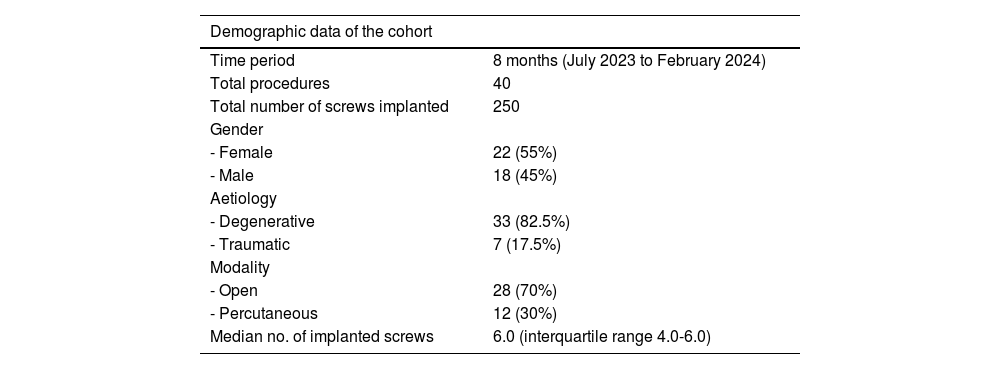The global incidence of spinal pathology is increasing due to the progressive aging of the population and increased life expectancy. Vertebral fixation with transpedicular screws is the most commonly used technique in unstable or potentially unstable pathologies. There are different implantation methods, the most recently developed being implantation guided by robotic navigation.
Materials and methodsWe describe the technical aspects and the different workflows available with the ExcelsiusGPS® robotic navigation system (GlobusMedical, Inc, Audubon, PA, USA), as well as the results of the first 40 patients operated on at the Hospital Universitario la Paz between July 2023 and February 2024.
ResultsA total of 250 screws were implanted at the thoracic and lumbar levels. 12 patients underwent minimally invasive surgery (MIS) (30%) and 28 patients underwent open surgery (70%). The median number of screws implanted per patient was 6.00 (4.00–6.00). The intraoperative malpositioning rate was 2.5% (1 case). The median duration of surgery was 143.00minutes (113.00–165.50). The median hospital stay was 4.00 days (3.00–5.50). The median intraoperative radiation delivered was 899mGy/cm2 (523.25–1595.00). The median blood loss was 150.00ml (100.00–300.00) and the blood transfusion rate was 0%.
DiscussionCompared to conventional techniques, Robotic spine surgery increases accuracy to 96–100% and reduces the radiation dose received by the patient and surgical team. In addition, it allows the implantation of larger screws, which has been associated with increased biomechanical strength and reduced risk of loosening. Initially, it may involve an increase in total surgical time, but this is reduced once the learning curve is reached, around 40 cases.
ConclusionsExcelsiusGPS® is the most recent robot model on the market and different studies have demonstrated its effectiveness in different techniques and indications. Unlike other robotic systems used exclusively in dorsolumbar spine pathology, it can be used in the pathology of the entire spinal axis (from C1 to the sacrum) and brain pathology (deep electrode implantation, brain biopsy, SEEG, among others).
La incidencia global de la patología de columna vertebral está en aumento debido al envejecimiento progresivo de la población y al incremento de la esperanza de vida. La fijación vertebral con tornillos transpediculares es la técnica más utilizada en patologías inestables o potencialmente inestables. Existen diferentes métodos de implantación, siendo la implantación guiada por navegación robótica el más recientemente desarrollado.
Material y métodosSe describen los aspectos técnicos y los diferentes flujos de trabajo disponibles con el sistema de navegación robótica ExcelsiusGPS® (GlobusMedical, Inc, Audubon, PA, USA), así como los resultados de los primeros 40 pacientes intervenidos en el Hospital Universitario la Paz en un período comprendido entre julio de 2023 y febrero de 2024.
ResultadosSe implantaron un total de 250 tornillos a nivel torácico y/o lumbar. Doce pacientes fueron sometidos a cirugía mínimamente invasiva (MIS) (30%) y 28 pacientes a cirugía abierta (70%). La mediana de tornillos implantados por paciente fue de 6.00 (4.00-6.00). La tasa de malposicionamiento intraoperatorio fue de 2.5% (1 caso). La mediana de duración de la cirugía fue de 143.00 minutos (113.00-165.50). La mediana de estancia hospitalaria fue de 4.00 días (3.00-5.50). La mediana de radiación emitida intraoperatoria fue de 899mGy/cm² (523.25-1595.00). La mediana de pérdida sanguínea fue de 150.00ml (100.00-300.00) y la tasa de transfusión sanguínea fue del 0%.
DiscusiónEn comparación con las técnicas convencionales, la cirugía robótica de columna aumenta la precisión al 96-100% y reduce la dosis de radiación recibida por el paciente y el equipo quirúrgico. Además, permite la implantación de tornillos de mayor tamaño, lo cual se ha relacionado con una mayor potencia biomecánica y una reducción del riesgo de aflojamiento. Inicialmente, puede suponer un aumento del tiempo quirúrgico total, pero este se reduce una vez se alcanza la curva de aprendizaje, situada en torno a los 40 casos.
ConclusionesExcelsiusGPS® es el modelo de robot más reciente del mercado y diferentes estudios han demostrado su efectividad en diferentes técnicas e indicaciones. A diferencia de otros sistemas robóticos empleados exclusivamente en patología de columna dorsolumbar, se puede emplear en patología de todo el eje espinal (de C1 hasta el sacro) y en patología cerebral (implantación de electrodos profundos, biopsia cerebral, SEEG, entre otros).
Article

If it is the first time you have accessed you can obtain your credentials by contacting Elsevier Spain in suscripciones@elsevier.com or by calling our Customer Service at902 88 87 40 if you are calling from Spain or at +34 932 418 800 (from 9 to 18h., GMT + 1) if you are calling outside of Spain.
If you already have your login data, please click here .
If you have forgotten your password you can you can recover it by clicking here and selecting the option ¿I have forgotten my password¿.














